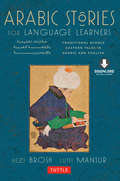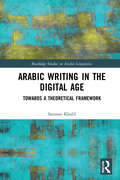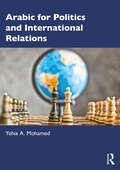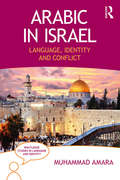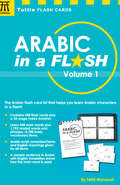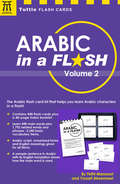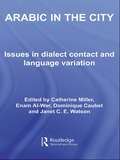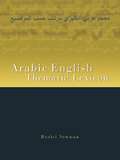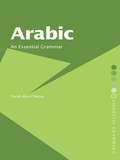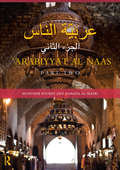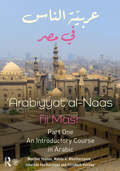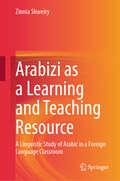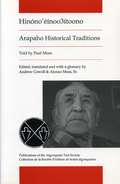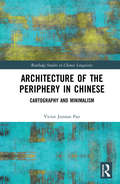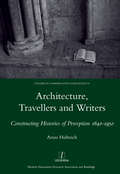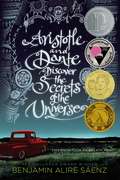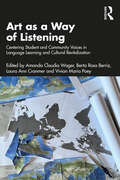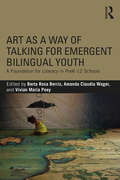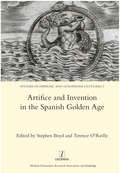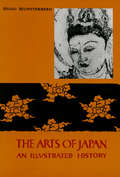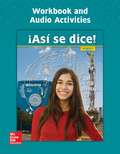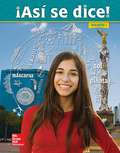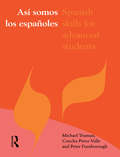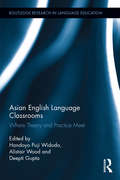- Table View
- List View
Arabic Stories for Language Learners
by Hezi Brosh Lutfi MansurArabic Stories for Language Learners--a language learning experience for beginner to intermediate students.The traditional stories of a country are invaluable at providing insight into understanding the culture, history and language of a people. The sixty-six stories found in Arabic Stories for Language Learners present the vocabulary and grammar used everyday in Arabic-speaking countries. Pulled from a wide variety of sources that have been edited and simplified for learning purposes, these stories are presented in parallel Arabic and English, facilitating language learning in the classroom and via self-study. Each story is followed by a series of questions in Arabic and English to test comprehension and encourage discussion.Arabic Stories for Language Learners brings Arab culture to life in a colorful and immediate way. Regardless of whether or not you have a working knowledge of Arabic, this book gives readers a tantalizing introduction to the wisdom and humor of these ancient desert-dwelling peoples. An audio CD in Arabic and English helps students of Arabic improve their pronunciation and inflection, and immerses non-students into the uniquely Arabic storytelling style.
Arabic Writing in the Digital Age: Towards a Theoretical Framework (Routledge Studies in Arabic Linguistics)
by Saussan KhalilThe written and spoken forms of Arabic have been traditionally viewed as separate forms of the language that rarely overlap in writing, but this book will examine the recently emerged concept of ‘mixed’ writing that combines both written and spoken forms. This book takes a close look at different examples of mixed Arabic writing in modern (twentieth to twenty-firstt century) print and online literature, offering an analysis of this type of mixing alongside a dynamic model for analysing mixed Arabic writing, and the motivations for producing this type of writing. This book further introduces the ground-breaking concept of the seven writing styles for Arabic, ranging from Classical Arabic to ChatSpeak, whilst also offering an overview of early Arabic literacy and children’s literature. Primarily aimed at Arabic researchers and teachers in linguistics, sociolinguistics, identity studies, politics and Teaching Arabic as a Foreign Language, this book would also be informative for undergraduate and postgraduate students studying Arabic as foreign language, Arabic linguistics and dialectology.
Arabic for Politics and International Relations
by Yehia A. MohamedArabic for Politics and International Relations is the first textbook for high-intermediate to advanced students of Arabic that focuses on Arabic as it is used in the fields of politics, diplomacy, governance, and international relations.Thematically organised, each chapter includes a selection of authentic reading texts that demonstrate the language in use while introducing students to a key topic or theme such as political systems, government, human rights, conflict resolution, and defence. Each chapter has a range of exercises that include comprehension questions, questions designed to develop vocabulary, understanding the morphology, rhetoric and style. There are a range of activities that allow students to practice all four language skills: reading, listening, speaking, and writing.Arabic for Politics and International Relations is ideal for advanced- level Arabic courses.
Arabic in Israel: Language, Identity and Conflict (Routledge Studies in Language and Identity)
by Muhammad AmaraIn Arabic in Israel, Muhammad Amara analyses the status of Arabic following the creation of the State of Israel and documents its impact on the individual and collective identity of Israel’s Palestinian Arab citizens. The interplay of language and identity in conflict situations is also examined. This work represents the culmination of many years of research on Arabic linguistic repertoire and educational policy regarding the language of the Palestinian citizens of Israel. It draws all of these factors together while linking them to local, regional and global developments. Its perspective is interdisciplinary and, as such, examines the topic from a number of angles including linguistic, social, cultural and political.
Arabic in a Flash Kit Volume 1
by Fethi MansouriArabic in a Flash: Volume I is an excellent new language learning resource for beginning students of Arabic.This unique set of flash cards enables learners to acquire basic Arabic words and their derivatives in an easy-to-use manner at whatever pace the learner prefers. Each card has Arabic script on one side, with romanized forms and English meanings/derivatives agiven on the other. Contains 448 flash cards plus a 32-page index booklet.Learn 448 main words plus 1,792 related words and phrases--2,700 basic vocabulary items.Arabic script, romanized forms and English meanings given for all items.A sample sentence in Arabic with English translation shows how the main word is used.
Arabic in a Flash Volume 2
by Fethi Mansouri Yousef AlreemawiArabic in a Flash: Volume 2 is an excellent language learning resource for beginning-intermediate students of Arabic.Hot on the success of Volume 1, Arabic in a Flash Volume 2 continues to develop the language skills of the beginning students and others interested in learning Arabic. While Volume 1 has a strong focus on basic communication and vocabulary-building, Volume 2 works to further develop vocabulary and introduces everyday activities, travel and leisure and economic and employment issues.Contains 448 flash cards plus a 48-page index booklet.Learn 448 main words plus 1,792 related words and phrases-2,240 basic vocabulary items.Arabic script, romanized forms and English meanings given for all items.A sample sentence in Arabic with its English translation shows how the main word is used.
Arabic in the City: Issues in Dialect Contact and Language Variation (Routledge Arabic Linguistics Series #Vol. 5)
by Janet C. E. Watson Enam Al-Wer Catherine Miller Dominique CaubetFilling a gap in the literature currently available on the topic, this edited collection is the first examination of the interplay between urbanization, language variation and language change in fifteen major Arab cities. The Arab world presents very different types and degrees of urbanization, from well established old capital-cities such as Cairo to new emerging capital-cities such as Amman or Nouakchott, these in turn embedded in different types of national construction. It is these urban settings which raise questions concerning the dynamics of homogenization/differentiation and the processes of standardization due to the coexistence of competing linguistic models. Topics investigated include: History of settlement The linguistic impact of migration The emergence of new urban vernaculars Dialect convergence and divergence Code-switching, youth language and new urban culture Arabic in the Diaspora Arabic among non-Arab groups. Containing a broad selection of case studies from across the Arab world and featuring contributions from leading urban sociolinguistics and dialectologists, this book presents a fresh approach to our understanding of the interaction between language, society and space. As such, the book will appeal to the linguist as well as to the social scientist in general.
Arabic-English Thematic Lexicon
by Daniel L. NewmanThe Arabic-English Thematic Lexicon is an invaluable resource for all learners of Arabic. It contains some 8,000 entries, arranged into themes, including flora and fauna, food and drink, the human body, health care, the family, housing, clothing, education, IT, sports, politics, economics and commerce, the law, media, language, geography, travel, religion, arts, science, and natural resources. Three appendices cover the names of Arab and selected non-Arab regions, countries and capitals, and international organizations. The entries in the Lexicon have been drawn from an extensive corpus of contemporary Standard Arabic vocabulary, based on authentic sources. In addition to verbs, nouns and adjectives, the Lexicon includes phrases and commonly used collocations, providing users with the necessary vocabulary in order to communicate effectively and confidently in both written and spoken standard Arabic. The Lexicon provides an indispensable complement to Arabic grammar instruction and also serves as a useful reference guide for all Arabic language users.
Arabic: An Essential Grammar
by Faruk Abu-ChacraArabic: An Essential Grammar is an up-to-date and practical reference guide to the most important aspects of the language. Suitable for beginners, as well as intermediate students, this book offers a strong foundation for learning the fundamental grammar and structure of Arabic. The complexities of the language are set out in short, readable sections, and exercises and examples are provided throughout. The book is ideal for independent learners as well as for classroom study. Features of this book include: coverage of the Arabic script and alphabet a chapter on Arabic handwriting a guide to pronunciation full examples throughout.
Arabiyyat al-Naas (Part Two): An Intermediate Course in Arabic
by Munther Younes Hanada Al-MasriArabiyyat al Naas (Part Two): An Intermediate Course in Arabic offers a vibrant course in Arabic as it is written and spoken today by educated native speakers. Not only does it continue the innovative integration of Modern Standard Arabic (MSA) and Levantine Arabic used in Part One of the series, but it does so in a way that supports and develops students’ increased mastery of the language. Combining a greater focus on cultural topics with an increased coverage of MSA, Part Two introduces more sophisticated communication, giving students a deeper awareness of the cultural base of the Arabic language. Features include: Twenty-one theme-based units covering a wide range of relevant and engaging topics, including education and learning, jobs and professions, the Arab woman, religion, money and the economy, politics and government and the environment Thorough coverage of listening, speaking, writing and reading skills in every unit, with lessons structured to provide students with variety, stimulation and further opportunities for practice Humorous, realistic dialogues reflecting everyday educated speech among Arabs to build up strong and practical communication skills A rich variety of reading passages, including poems, short stories, newspaper articles, descriptions of Arab cities and biographies of famous figures, designed to improve comprehension and analytical skills and to deepen students’ knowledge of Arab history, culture, language, and literature An extensive range of appealing exercises and activities, including crossword puzzles, root-and-pattern identification exercises, passage completions, guided and free compositions, and songs Free accompanying CD that includes audio recordings of the listening materials in the 21 units and a number of songs tied to their themes Free companion website (www.routledge.com/cw/younes) featuring the texts of the listening passages, the audio recordings available on the CD , a track list of all the audio materials, the answer keys to the crossword puzzles, sample tests and language games. Developed by an experienced and dynamic author team and tested over a number of years at Cornell University, Arabiyyat al Naas (Part Two) will be an essential resource for intermediate-level students of Arabic. While primarily designed for classroom use, the accessibility of the course also renders it highly suitable for independent study. This volume is the second in a pioneering three-part series of Arabic textbooks which together provide a complete three-year undergraduate language program.
Arabiyyat al-Naas fii MaSr (Part One): An Introductory Course in Arabic
by Makda Weatherspoon Munther Younes Jonathan Featherstone Elizabeth Huntley‘Arabiyyat al-Naas fii MaSr (Part One) offers a ground-breaking introduction to Arabic as it is written and spoken by native speakers. It combines a progressive and rigorous grounding in Modern Standard Arabic (MSA), the register employed for reading, writing and formal speaking, with an innovative integration of the dominant Egyptian variety. Introducing the two simultaneously and seamlessly building on their shared features, ‘Arabiyyat al-Naas fii MaSr (Part One) uses each in its proper context: Egyptian dialect for conversations and MSA for reading and writing activities. In this way, the course efficiently prepares students for the practical realities of learning and living Arabic today. Features include: Expanded grammar explanations and activation drills, including discussions about colloquial and formal similarities and differences A series of authentic video-clips recorded in Egypt to help learners revise the vocabulary and structures then learn unit by unit Extensive classroom activities and homework exercises that provide constant review to reinforce learning Arabic-English and English-Arabic glossaries, reference charts, and a grammar index Songs with simple lyrics tied to the themes of the course to help advance vocabulary acquisition and understanding of basic grammatical structures A companion website (www.routledge.com/cw/weatherspoon) that features fully integrated interactive, self-correcting exercises, audio and video materials, and additional online course management and grading options for teachers A user-friendly and vibrant text design with full colour, richly illustrated throughout with over two hundred illustrations and photos A teachers manual with an Arabic introduction for the teacher, which lays out the structure of the student course book, its methodology and directions and suggestions for its use. Written by experienced teachers of Arabic and experts in Arabic teaching pedagogy, ‘Arabiyyat al-Naas fii MaSr (Part One) is an essential resource for students beginning to learn Arabic.
Arabizi as a Learning and Teaching Resource: A Linguistic Study of Arabic in a Foreign Language Classroom
by Zinnia ShweiryThis book is the first of its genre to explore the use of Arabizi, the Romanized script of the Arabic language that is used online or in chat apps, in the Arabic as a Foreign Language (AFL) classroom. It fills a noticeable, and glaring, gap in teaching a non-Romanized language through Romanized representation by observing and studying Arabizi as a resource that is yet to be acknowledged. As such, the author aptly, and concurrently, addresses concerns and problems that arise in AFL learning. An essential resource for studies in language acquisition, the author carves a new niche in the study of phonology, and phonetics, particularly so in L1 and L2 studies, with succinct and up-to-date examples. Relevant to applied linguistics and language educators in Arabic, it also draws comparisons between Chinese and Arabic alphabets in analyzing L1 and L2 purposes, making it a unique linguistic comparative contribution to the study of languages in classroom settings.
Arapaho Historical Traditions: Hinono'einoo3itoono (Algonquian Text Society)
by Alonzo Moss, Sr.Told by Paul Moss (1911-1995), a highly respected storyteller and ceremonial leader, these twelve texts introduce us to an immensely rich literature. As works of an oral tradition, they had until now remained beyond the reach of those who do not speak the Arapaho language. Here, for the first time, these outstanding examples of indigenous North American literature are printed in their original language (in the standard orthography used on the Wind River Reservation) but made accessible to a wider audience through English translation and comprehensive introductions, notes, commentaries and an Arapaho-English glossary.The Arapaho traditions chosen for this anthology tell of hunting, scouting, fighting, horse-stealing, capture and escape, friendly encounters between tribes, diplomacy and war, conflict with the U.S. and battles with its troops. They also include accounts of vision quests and religious rites, the fate of an Arapaho woman captured by Utes, and Arapaho uses of the "Medicine Wheel"in the Bighorn Mountains.
Architecture of the Periphery in Chinese: Cartography and Minimalism (Routledge Studies in Chinese Linguistics)
by Victor Junnan PanArchitecture of the Periphery in Chinese offers a comprehensive survey on the fine structure of the sentence peripheral domain in Mandarin Chinese from a cartographic perspective. Different functional projections hosting sentence-final particles, implicit operators and other informational components are hierarchically ordered according to the "Subjectivity Scale Constraint" functioning at syntax-discourse interface. Three questions will be essentially addressed: What is the order? How to determine such an order? Why such an order? This research not only gives a thorough examination of the peripheral elements in Chinese but also improves the general understanding of the ordering issue in the left-periphery crosslinguistically. This book is aimed at scholars interested in Chinese syntax or generative syntax.
Architecture, Travellers and Writers: Constructing Histories of Perception 1640-1950
by Anne HultzschDoes the way in which buildings are looked at, and made sense of, change over the course of time? How can we find out about this? By looking at a selection of travel writings spanning four centuries, Anne Hultzsch suggests that it is language, the description of architecture, which offers answers to such questions. The words authors use to transcribe what they see for the reader to re-imagine offer glimpses at modes of perception specific to one moment, place and person. Hultzsch constructs an intriguing patchwork of local and often fragmentary narratives discussing texts as diverse as the 17th-century diary of John Evelyn, Daniel Defoe's Robinson Crusoe (1719) and an 1855 art guide by Swiss art historian Jacob Burckhardt. Further authors considered include 17th-century collector John Bargrave, 18th-century novelist Tobias Smollett, poet Johann Wolfgang von Goethe, critic John Ruskin as well as the 20th-century architectural historian Nikolaus Pevsner. Anne Hultzsch teaches at the Bartlett School of Architecture, University College London.
Aristóteles y Dante descubren los secretos del universo (Infantil y Juvenil)
by Benjamin Alire SaenzAristóteles es introvertido y tímido. Dante es transparente y expresivo. Por motivos que parecen escapar a toda razón, estos dos chicos de diecisiete años se encuentran y construyen una amistad entrañable que les permitirá redefinir el mundo del otro y aprender a creer en ellos mismos para descubrir los secretos del universo. El escritor multipremiado, Benjamin Alire Sáenz, explora la lealtad y la confianza entre dos jóvenes que están aprendiendo a ser adultos en un escenario fronterizo tan mexicano como estadounidense. Juntos deberán crecer al mismo tiempo en que se adaptan a una sociedad que también está búsqueda, identidad.
Arma, tiro, bammm!
by Joan Mari Irigoien Aranberri?Hamzak, beraz, leherketa hura zuen jada buruan: izango ez zuen, bada, puntuari begira zegoela musika hura etorri bazitzaion, bamm bamm-bamm? musika hura, bai, gorputzean ere sentitzen zuena, bere gorputza zuhaitz bat balitz bezala, zainak adartzat zituena eta bere bihotz hura fruitutzat; bihotz hura, soka bakarreko lautak bezala, bamm-bamm-bamm egiten zuena, sistoleak eta diastoleak bat eginik; musika hura, segundo gutiren buruan erabateko bakera eraman zuena: BAMMM!? Hari bi nobela bakar berean: batetik, Bereibarko familia bat (Gipuzkoa eta Bizkaia arteko alegiazko herria) bizibidez eskopeta-lantegi bat daukana; bestetik, Balad al Xams-eko (Ekialde Hurbileko balizko herrialdea) beste familia bat, gerra ahaztu baten ondorioak nozitu beharko dituena; modu paraleloan kontatzen zaizkigu batzuen nahiz besteen pozak eta nekeak, eguneroko kontu xeheak eta Historia markatzen duten gertakari handiak, XX. mendeko bigarren erdian hasi eta gaur arte. Hari biek, halabeharrez, bat egiten duten arte. Ez da ohikoa arma trafikoa gaitzat hartzea eleberri batean; irakurlearen gogo-bihotzak inarrosteko asmo osoz egin du Joan Mari Irigoienek, eta helburu horri begira erabili bere artearen tresna guztiak. Hiru ezaugarriok nabarmendu daitezke egilearen lanean: hizkuntzaren erabilera zaindu eta ederra, hainbat istorio sortu eta kateatzeko fabulazio-ahalmen itzela, eta gure gizarteko gai minberak ukitzeko kontzientzia etikoa.
Art as a Way of Listening: Centering Student and Community Voices in Language Learning and Cultural Revitalization
by Berta Rosa Berriz Amanda Claudia Wager Vivian Maria Poey Laura Ann CranmerOffering a wealth of art-based practices, this volume invites readers to reimagine the joyful possibility and power of language and culture in language and literacy learning. Understanding art as a tool that can be used for decolonizing minds, the contributors explore new methods and strategies for supporting the language and literacy learning skills of multilingual students. Contributors are artists, educators, and researchers who bring together cutting-edge theory and practice to present a broad range of traditional and innovative art forms and media that spotlight the roles of artful resistance and multilingual activism. Featuring questions for reflection and curricular applications, chapters address theoretical issues and pedagogical strategies related to arts and language learning, including narrative inquiry, journaling, social media, oral storytelling, and advocacy projects. The innovative methods and strategies in this book demonstrate how arts-based, decolonizing practices are essential in fostering inclusive educational environments and supporting multilingual students’ cultural and linguistic repertoires. Transformative and engaging, this text is a key resource for educators, scholars, and researchers in literacy and language education.
Art as a Way of Talking for Emergent Bilingual Youth: A Foundation for Literacy in PreK-12 Schools
by Berta Rosa Berriz Amanda Claudia Wager Vivian Maria PoeyThis book features effective artistic practices to improve literacy and language skills for emergent bilinguals in PreK-12 schools. Including insights from key voices from the field, this book highlights how artistic practices can increase proficiency in emergent language learners and students with limited access to academic English. Challenging current prescriptions for teaching English to language learners, the arts-integrated framework in this book is grounded in a sense of student and teacher agency and offers key pedagogical tools to build upon students’ sociocultural knowledge and improve language competence and confidence. Offering rich and diverse examples of using the arts as a way of talking, this volume invites teacher educators, teachers, artists, and researchers to reconsider how to fully engage students in their own learning and best use the resources within their own multilingual educational settings and communities.
Artifice and Invention in the Spanish Golden Age
by Stephen BoydThe corpus of literary works shaped by the Renaissance and the Baroque that appeared in Spain during the sixteenth and seventeenth centuries had a transforming effect on writing throughout Europe and left a rich legacy that scholars continue to explore. For four decades after the Spanish Civil War the study of this literature flourished in Great Britain and Ireland, where many of the leading scholars in the field were based. Though this particular 'Golden Age' was followed by a decline for many years, there have recently been signs of a significant revival. The present book seeks to showcase the latest research of established and younger colleagues from Great Britain and Ireland on the Spanish Golden Age. It falls into four sections, in each of which works by particular authors are examined in detail: prose (Miguel de Cervantes, Francisco de Quevedo, Baltasar Gracian), poetry (The Count of Salinas, Luis de Gongora, Pedro Soto de Rojas), drama (Cervantes, Calderon, Lope de Vega), and colonial writing (Bernardo Balbuena, Hernando Dominguez Camargo, Alonso de Ercilla). There are essays also on more general themes (the motif of poetry as manna; rehearsals on the Golden Age stage; proposals put to viceroys on governing Spanish Naples). The essays, taken together, offer a representative sample of current scholarship in England, Scotland, and Ireland.
Arts of Japan
by Hugo MunsterbergArts of Japan was originally published by Tuttle Publishing in print form in 1957.<P><P> This book," in the words of the author, "represents an attempt to fill a long-felt need for an account of the history of Japanese art which would deal with the crafts as well as with the so-called fine arts and carry the story of Japanese art up to the present day instead of ending with the death of Hiroshige." The reader will quickly perceive how well this aim has been achieved. Here, in a stimulating and informative text and 121 well-selected plates -12 in full colour-is a dynamic treatment of the various influences that have shaped the course of Japanese art history in the fields of painting, sculpture, architecture, and handicrafts. Discussed with challenging insight are the impact of the various Indian and Chinese schools, the pervasive influenceof Zen philosophy, and the many other artistic developments, giving the reader awell-rounded picture of the great significance and contribution of Japanese art. Special features of the book are sections on handicrafts and a chapter on prehistoric art. The book comes at a time when there is an awakened interest in Oriental art throughout the world. At the same time new methods of art research have been so expanded and refined that many interpretations of earlier writers have been made obsolete. Because of linguistic barriers, political upheavals, and the limited number of specialists, misconceptions have been especially numerous in the field of Oriental art. THE ARTS OF JAPAN admirably corrects these misinterpretations, consolidates the results of the most recent scholarship, and in one compact volume presents an up-to-date, authoritative survey of Japanese an throughout its long history and in all its colorful diversity.
Asi Se Dice! Level 1 (Asi Se Dice)
by Conrad J. SchmittThis is the textbook for level 1 of the popular Spanish language learning series
Asi somos los espanoles: Spanish Skills for Advanced Students
by Peter Furnborough Concha Pérez Valle Michael TrumanAsí somos los españoles provides advanced students with a genuine insight into Spanish culture via a range of practical activities and exercises. The courses includes many unscripted recordings of interviews with Spaniards from a variety of geographical areas. Students explore these recordings through activities designed to develop listening, speaking, reading and writing skills.This course suitable for classroom use or independent learning.
Asian English Language Classrooms: Where Theory and Practice Meet (Routledge Research in Language Education)
by Alistair Wood Handoyo Puji Widodo Deepti GuptaThe teaching of English in the Asian context is always challenging and dynamic because both teachers and learners have diverse linguistic and cultural backgrounds. Equally important, where English is not widely used outside the classroom, English language classrooms are an authentic site of learner engagement. For these reasons, for all those concerned with contemporary English language teaching (ELT) in Asia, Asian English Language Classrooms: Where Theory and Practice Meet, provides an account of theoretical orientations and practices in the teaching of English to multilingual speakers whose primary language is not English. While covering the fundamental ELT areas (e.g., the teaching of language skills, educational literature, the use of technology in ELT, the role of pragmatics in ELT, social psychology of the language classroom, and language classroom management) with which every language teacher and teacher trainer must be concerned, this volume showcases how particular orientations shape ELT practices. We believe that practicing English teachers must have a heightened awareness of the theory behind their practice. At the same time, the theoretical stance must be firmly anchored in actual classrooms. Containing newly commissioned chapters written by well-regarded and emerging scholars, this book will appeal not only to beginning teachers or teachers in training but also to established teachers around Asia where English is used as a lingua franca. If you are a student teacher of English or an English teacher who would like to see what other progressive teachers like you are doing across Asia, this is the book you have been looking for.
